(No, we are not that crazy! We don't go out to the open shore when there is lightning. The guides will show up at the appointed place and time, but we will sit and wait for the weather to clear.)
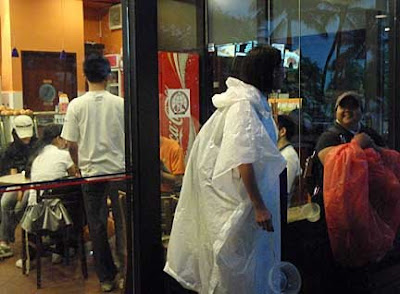 That's H and CH with their bright ponchos outside the cafe, checking the weather.
That's H and CH with their bright ponchos outside the cafe, checking the weather. While LK chatted with the Neo family to find out more about what they expect to see on the shore.
While LK chatted with the Neo family to find out more about what they expect to see on the shore.
Finally the weather cleared, off we went!
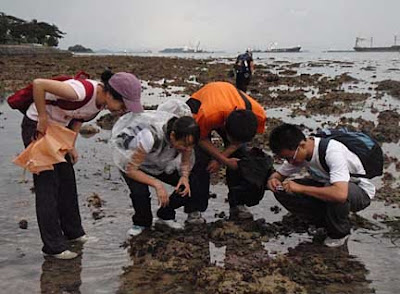 R led a group of Chinese students and they were wonderfully enthusiastic about the trip!
R led a group of Chinese students and they were wonderfully enthusiastic about the trip! 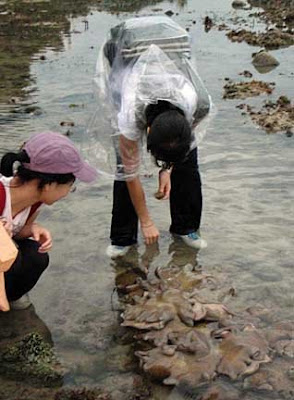 They were excited to see many of the common animals on Sentosa's natural shores such as hard corals, soft corals and even sponges which come in such a wide variety of shapes and colours. The picture above showed a magnificent giant soft coral with mushroom coral and sponges around it.
They were excited to see many of the common animals on Sentosa's natural shores such as hard corals, soft corals and even sponges which come in such a wide variety of shapes and colours. The picture above showed a magnificent giant soft coral with mushroom coral and sponges around it.We also talked about seagrasses and the many kinds of seaweeds.
The 3 kids in LK's group were equally excited to see the little brown egg crab, 2 tiny hairy crabs and some of the snails. They now understand that the brown egg crab is poisonous. The kids asked about the black sea cucumber (they read our blog lah!), but we did not see any today.
 Because the China students were science students, the Crabs could go all out and explain things like chemical defences, zooxanthallae, impact of carbon dioxide and acid oceans, and other fascinating concepts which seemed to interest them too.
Because the China students were science students, the Crabs could go all out and explain things like chemical defences, zooxanthallae, impact of carbon dioxide and acid oceans, and other fascinating concepts which seemed to interest them too. 
Here they are taking a closer look at the large acropora hard coral which is a rather rare hard coral on our shores.
Overall the students asked really good questions like "there seems to be a complete food chain on the shore, so what is the top predator?". To which of course we had to sadly say most of the top predators in a natural food chain have been affected by development. In natural circumstances, top predators such as otters and large fishes such as groupers would probably be more common on our Sentosa shores.
 CH and H found nudis! Wow. And CH explained the delightful properties of these amazing creatures.
CH and H found nudis! Wow. And CH explained the delightful properties of these amazing creatures.  And here is the unusual nudibranch. There were 2 of them in fact. And when CH and H found them, they were 'hanging around' the seagrasses. This particular nudibranch, Phyllodesmium briareum, feeds on soft corals. It also contains symbiotic zooxantellae that makes food and thus supply nutrients to the animal.
And here is the unusual nudibranch. There were 2 of them in fact. And when CH and H found them, they were 'hanging around' the seagrasses. This particular nudibranch, Phyllodesmium briareum, feeds on soft corals. It also contains symbiotic zooxantellae that makes food and thus supply nutrients to the animal. It continued to drizzle and when the rain got heavier again, we returned to shore. But everyone was glad to have an introduction to the marine bio-diversity found on Sentosa.
It continued to drizzle and when the rain got heavier again, we returned to shore. But everyone was glad to have an introduction to the marine bio-diversity found on Sentosa.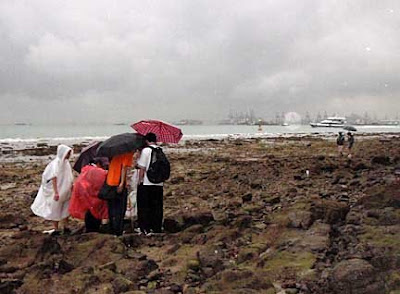 Here's a little bit more information about the wonderful group of China students who came today. They will be starting their undergraduate studies in July but had arrived in Singapore last December to start on their bridging course. They are a bunch of bright happy kids. They told us that they are trying to adapt to the Singapore environment, soaking in all that is good and not-so-good about Singapore - the climate, culture, society and food.
Here's a little bit more information about the wonderful group of China students who came today. They will be starting their undergraduate studies in July but had arrived in Singapore last December to start on their bridging course. They are a bunch of bright happy kids. They told us that they are trying to adapt to the Singapore environment, soaking in all that is good and not-so-good about Singapore - the climate, culture, society and food.They came to know about our nature walks through the Lianhe Zaobao article last Monday. From the article, they found it hard to believe that there are so many unique marine creatures on Singapore shores. Animals that they only saw on TV documentary programmes! In a way, I guess the newspaper report opened their eyes to the natural beauty of Singapore, and I am sure they will go in search of the same natural beauty when they return to their homeland.
LX who booked this trip with us explained that he comes from an island, that is about the same size as Singapore, located in the Zhejiang province. In his words, he wrote, "A few years ago, it was the largest fishery port in China. Because of years of excessive fishing, the marine resources decreased. So we took many measures to protect our environment, such as prohibition of fishing during certain mouths. And it works."
We're really happy to have brought the students and the Neo family out on the shore. We wish you "Happy nature exploring!"
Total number of visitors today = 12
Total number of guides = 4 (Ria, LK, CH and Helen)
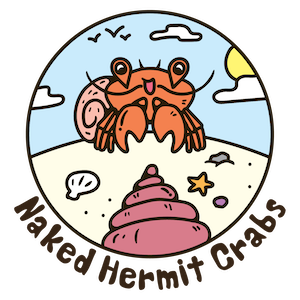
No comments:
Post a Comment